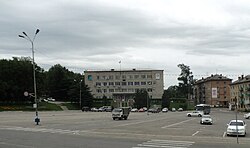Partizansk
| Partizansk (English) Партизанск (Russian) |
|
|---|---|
| - Town - | |
 Partizansk town center |
|
 Location of Primorsky Krai in Russia |
|
|
|
|
|
|
|
|
|
|
| Administrative status (as of December 2013) | |
| Country | Russia |
| Federal subject | Primorsky Krai |
| Administratively subordinated to | Partizansk Town Under Krai Jurisdiction |
| Administrative center of | Partizansk Town Under Krai Jurisdiction |
| Municipal status (as of November 2012) | |
| Urban okrug | Partizansky Urban Okrug |
| Administrative center of | Partizansky Urban Okrug |
| Head | Alexey Neshchadim |
| Statistics | |
| Population (2010 Census) | 38,659 inhabitants |
| Time zone | VLAT (UTC+10:00) |
| Founded | 1896 |
| Town status since | 1932 |
| Previous names |
Suchansky Rudnik, Suchan (until 1932), Gamarnik, Suchan (until 1937) |
| Dialing code(s) | +7 692851–692854, 692856, 692858, 692860, 692861, 692864, 692867–692869 |
|
|
|
| on | |
Partizansk (Russian: Партиза́нск) is a town in Primorsky Krai, Russia, located on a spur of the Sikhote-Alin Mountains, about 170 kilometers (110 mi) east of Vladivostok, the administrative center of the krai. Population: 38,659 (2010 Census);43,670 (2002 Census);49,546 (1989 Census).
The town was formerly known as Suchan (Chinese: 蘇城; pinyin: Sūchéng), but its Russian name was changed to Partizansk in 1972 during a general campaign of cleansing the Chinese toponyms in Outer Manchuria.
A number of creeks flow through the town into the nearby Partizanskaya River, previously known as the Suchan.
Partizansk has a four-season humid continental climate. Its climate contains vast temperature differences between seasons, in spite of its relatively low latitude and position near the Pacific Ocean. It has slightly warmer summers than Vladivostok due to its inland position, whereas winters are similar in both locations, largely but not completely unaffected by any maritime moderation. The cold temperatures for the latitude are due to the Siberian High's influence. The climate features wet and humid summers as well as dry and snow-light winters.
In the late 19th century, the Vladivostok-based Russian Pacific Fleet was in deep need of a source of coal. The Department of Mines sent a geological expedition to the area south of Ussuriysk, working there from 1888 to 1893. Coal was found, which could be mined and sent to Nakhodka for the needs of the Fleet. In 1896, the Department of Mines made a large order for coal from the Suchan River area, and a settlement for miners was founded. The settlement was originally named Suchansky Rudnik, meaning mining pit of Suchan.
...
Wikipedia



